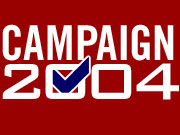Audio
Photos
Your Voice
| ||||||||||||||||||||||||||||||||||||||
Practicing retail politics at the State Fair
August 31, 2004
The Republican National Convention in New York is in the spotlight this week -- but it's certainly not the only political game in town. The Minnesota State Fair is a traditional hotbed for retail politics, and it's an important venue for smaller parties that can't afford the high production values of the Democrats' and Republicans' campaigns.
St. Paul, Minn. — If President George Bush isn't your man and Sen. John Kerry leaves you flat, you can always try Michael Peroutka. Peroutka is the nominee of the Constitution Party, and though he might get washed out in the campaign coverage between now and November, you can learn more about him at the State Fair Grandstand.
Brian Ducklinsky is a volunteer for the Constitution Party, a movement built around the Bible, the U.S. Constitution, and traditional values. And though the Constitution booth isn't attracting as much attention as the high-definition television display next door, Ducklinsky says he's nonetheless getting the word out.
"It's been a mixed response. People seem to be interested. They at least get some information," says Ducklinsky. "I've had people on both sides of the issue, asking me questions. And I try to answer them."
The Constitution Party attained major party status in Minnesota when its state auditor candidate topped 5 percent in the 1998 election. At the time, the party was known as the Taxpayer's Party. It's since slipped back into the ranks of the minors where, like other third parties, it fights the perception that its candidates can't win.
|
These are candidates that can win their (local) races. All you have to say is they have a good chance of winning and people become much more interested, because they are looking for alternatives.
- Darrell Gerber, Green Party |
Down the hallway, the Green Party is doing a brisker business. David Cobb is the Green presidential nominee this year. Many voters still blame the party and 2000 candidate Ralph Nader for tipping the last presidential election to Bush. Green activist Darrell Gerber says he hears certain voters worry about a similar result this year -- and he says he understands the temptation to stick with Kerry or Bush at the top of the ticket.
"We could say, 'That's fine, if that's what you want to do at the presidential level, but we have these other local candidates,'" says Gerber. "These are candidates that can win their races. All you have to say is they have a good chance of winning and people become much more interested, because they are looking for alternatives."
And the local level, really, is where third parties have their biggest success stories. The Greens have eight locally-elected officials in Minnesota, and in urban centers like Minneapolis, they're at least as strong -- if not stronger -- than the Republicans.
This year, the Greens are running six endorsed candidates for the state House, two for U.S. Congress, and one for Bemidji City Council. But there's still the tricky task of convincing voters to take a chance with a third party candidate.
Charles Aldrich of Burnsville is running for the state House on the Libertarian ticket. He says the key is to tap into those voters who are otherwise tuned out.
"In Burnsville, we've got 60,000 people living there. We've got 20,000 registered voters. If half of the people who don't normally vote decided to vote for the Libertarian Party, we would win by a landslide there," says Aldrich.
That strategy played well for the state's most famous third-party candidate -- former Gov. Jesse Ventura. In 1998, Ventura won election in part by luring first-time and disaffected voters out of their malaise and into the voting booths.
The Independence Party has had difficulty replicating that success since then, although in 2002 they did win a seat in the state Senate when incumbent Sheila Kiscaden of Rochester left the GOP for the Independence Party. Since then, IP state chair Jim Moore says support has continued to grow.
"The quality of our candidates is solid. The support we get in every election cycle is getting larger and larger," Moore says. "So it's not something that happens overnight. But it's incumbent upon us to put forth candidates where we can create something -- like Jesse Ventura -- that can happen overnight."
But 2002 also saw a disappointing third place finish for IP gubernatorial candidate Tim Penny. And while the IP had 28 endorsed House candidates the last time, that number's dropped by nearly half -- down to 16 -- for this year. The party also has candidates in three races for the U.S. Congress.
|
News Headlines
|
Related Subjects
|


